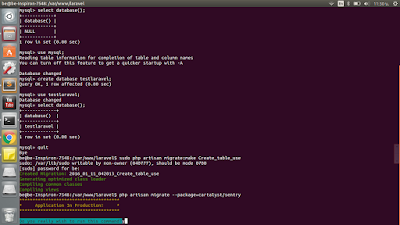การสร้างฟอร์ม Login / Register
****ก่อนการสร้างฟอร์มต้องทำการสร้าง database และมี table แล้ว หากยังไม่ได้ทำสามารถศึกษาได้จาก
การสร้างdatabase และ การสร้าง table
1. ทำการเปิดไฟล์
HomeController.php ที่อยู่ใน /var/www/laravel/app/controllers/ เพื่อแก้ไข
ดังนี้
<?php
class HomeController extends BaseController {
/*
|--------------------------------------------------------------------------
| Default Home Controller
|--------------------------------------------------------------------------
|
| You may wish to use controllers instead of, or in addition to, Closure
| based routes. That's great! Here is an example controller method to
| get you started. To route to this controller, just add the route:
|
| Route::get('/', 'HomeController@showWelcome');
|
*/
public function showWelcome()
{
return View::make('hello');
}
public function getRegister()
{
return View::make('home.register');
}
public function getLogin()
{
return View::make('home.login');
}
public function postRegister()
{
try
{
$user = Sentry::createUser(array(
'first_name' => Input::get('first_name'),
'last_name' => Input::get('last_name'),
'email' => Input::get('email'),
'password' => Input::get('password'),
'activated' => true,
));
}
catch (Cartalyst\Sentry\Users\UserExistsException $e)
{
echo 'User Already Exists';
}
}
public function postLogin()
{
$credentials = array(
'email' => Input::get('email'),
'password' => Input::get('password'),
);
try{
$user = Sentry::authenticate($credentials, false);
if($user)
{
return Redirect::to('admin');
}
}
catch (\Exception $e)
{
return Redirect::to('login')->withErrors(array('login' => $e->getMessages()));
}
}
public function logout()
{
Sentry::logout();
return Redirect::to('/');
}
}
2. ทำการสร้างหน้า Login / Register
โดยทำการ New folder ที่ /var/www/laravel/app/views/ชื่อ folder ว่า layoutsทำการสร้างไฟล์ ขึ้นมาชื่อdefault.blade.php
ทำการเพิ่ม code ลงไป ดังนี้
<!doctype html>
<html lang="en">
<head>
<meta charset="UTF-8">
<title></title>
{{ HTML::style('//netdna.bootstrapcdn.com/bootstrap/3.1.1/css/bootstrap.min.css') }}
</head>
<body>
@yield('content')
{{ HTML::script('//ajax.googleapis.com/ajax/libs/jquery/1.11.0/jquery.min.js') }}
{{ HTML::script('//netdna.bootstrapcdn.com/bootstrap/3.1.1/js/bootstrap.min.js') }}
</body>
</html>
ดังภาพที่ 1.1
ภาพที่ 1.1
3. สร้าง file login
โดยสร้าง Folder ใหม่ ไว้ใน /var/www/laravel/app/views/ ชื่อ Folder ว่า home และทำการส้รางไฟล์ใหม่ขึ้นมาชื่อว่า login.blade.php
ทำการเพิ่ม code ลงไป ดังนี้
@extends('layouts.default')
@section('content')
<div class="col-md-4 col-md-offset-4">
<div class="panel panel-info">
<div class="panel-heading">Please Login</div>
<div class="panel-body">
{{ Form::open(array('url' => 'login')) }}
@if($errors->has('login'))
<div class="alert alert-danger">
<a href="#" class="close" data-dismiss="alert">×</a>
{{ $errors->first('login', ':message') }}
</div>
@endif
<div class="form-group">
{{ Form::label('email', 'Email Address') }}
{{ Form::text('email', '', array('class' => 'form-control', 'placeholder' => 'Email Address')) }}
</div>
<div class="form-group">
{{ Form::label('password', 'Password') }}
{{ Form::password('password', array('class' => 'form-control', 'placeholder' => 'Password')) }}
</div>
<div class="form-group">
{{ Form::submit('Login', array('class' => 'btn btn-success')) }}
{{ HTML::link('/', 'Cancel', array('class' => 'btn btn-danger')) }}
</div>
{{ Form::close() }}
</div>
</div>
</div>
ดังภาพที่ 1.2
ภาพที่ 1.2
4. ทำการเพิ่ม Register ไว้ในที่เดียวกันโดยใช้ชื่อ register.blade.php โดยเพิ่ม code ลงไป ดังนี้
@extends('layouts.default')
@section('content')
<div class="col-md-4 col-md-offset-4">
<div class="panel panel-info">
<div class="panel-heading">Please Register</div>
<div class="panel-body">
{{ Form::open(array('url' => 'register')) }}
@if($errors->any())
<div class="alert alert-danger">
<a href="#" class="close" data-dismiss="alert">×</a>
{{ implode('', $errors->all('<li class="error">:message</li>')) }}
</div>
@endif
<div class="form-group">
{{ Form::label('fname', 'First Name') }}
{{ Form::text('first_name', '', array('class' => 'form-control', 'placeholder' => 'First Name')) }}
</div>
<div class="form-group">
{{ Form::label('last_name', 'Last Name') }}
{{ Form::text('last_name', '', array('class' => 'form-control', 'placeholder' => 'Last Name')) }}
</div>
<div class="form-group">
{{ Form::label('email', 'Email Address') }}
{{ Form::text('email', '', array('class' => 'form-control', 'placeholder' => 'Email Address')) }}
</div>
<div class="form-group">
{{ Form::label('password', 'Password') }}
{{ Form::password('password', array('class' => 'form-control', 'placeholder' => 'Password')) }}
</div>
<div class="form-group">
{{ Form::submit('Register', array('class' => 'btn btn-success')) }}
{{ HTML::link('/', 'Cancel', array('class' => 'btn btn-danger')) }}
</div>
{{ Form::close() }}
</div>
</div>
</div>
@stop
จะได้ดังภาพที่ 1.3
ภาพที่ 1,3
5. หลังจากนั้น ทำการแก้ไขไฟล์ routes.php ซึ่งอยู่ใน /var/www/laravel/app/
โดยเพิ่ม code ลงไปในบรรทัดสุดท้ายของหน้าดังนี้
Route::get('register', 'HomeController@getRegister');
Route::get('login', 'HomeController@getLogin');
Route::post('login', 'HomeController@postLogin');
Route::post('register', 'HomeController@postRegister');
Route::group(array('before' => 'auth'), function(){
Route::get('admin', 'AdminController@index');
Route::get('logout', 'HomeController@logout');
});ดังภาพที่ 1.4
ภาพที่ 1.4
6. จากนั้น ทำการแก้ไขไฟล์ fifters.php ซึ่งอยู่ใน /var/www/laravel/app/
โดยนำ code ดังนี้ ไปวางทับ code เดิม
<?php
/*
|--------------------------------------------------------------------------
| Application & Route Filters
|--------------------------------------------------------------------------
|
| Below you will find the "before" and "after" events for the application
| which may be used to do any work before or after a request into your
| application. Here you may also register your custom route filters.
|
*/
App::before(function($request)
{
//
});
App::after(function($request, $response)
{
//
});
/*
|--------------------------------------------------------------------------
| Authentication Filters
|--------------------------------------------------------------------------
|
| The following filters are used to verify that the user of the current
| session is logged into this application. The "basic" filter easily
| integrates HTTP Basic authentication for quick, simple checking.
|
*/
// Route::filter('auth', function()
// {
// if (Auth::guest()) return Redirect::guest('login');
// });
Route::filter('auth', function(){
if(!Sentry::check()) return Redirect::guest('login');
});
Route::filter('auth.basic', function()
{
return Auth::basic();
});
/*
|--------------------------------------------------------------------------
| Guest Filter
|--------------------------------------------------------------------------
|
| The "guest" filter is the counterpart of the authentication filters as
| it simply checks that the current user is not logged in. A redirect
| response will be issued if they are, which you may freely change.
|
*/
Route::filter('guest', function()
{
if (Auth::check()) return Redirect::to('/');
});
/*
|--------------------------------------------------------------------------
| CSRF Protection Filter
|--------------------------------------------------------------------------
|
| The CSRF filter is responsible for protecting your application against
| cross-site request forgery attacks. If this special token in a user
| session does not match the one given in this request, we'll bail.
|
*/
Route::filter('csrf', function()
{
if (Session::token() != Input::get('_token'))
{
throw new Illuminate\Session\TokenMismatchException;
}
});
7. จากนั้นสร้าง Folder ใหม่ ไว้ใน /var/www/laravel/app/views/
ชื่อ Folder ว่า admin ทำการส้รางไฟล์ใหม่ โดยใช้ชื่อว่า index.blade.php
@extends('layouts.default')
@section('content')
<h2>Admin Section</h2>
{{ HTML::link('logout', 'Logout', array('class' => 'btn btn-warning'))}}
@stop
8. ทำการสร้างไฟล์ชื่อว่า AdminController.php ไว้ใน /var/www/laravel/app/controller.php โดย เพิ่ม code ดังนี้
<?php
class AdminController extends BaseController {
/**
* Display a listing of the resource.
*
* @return Response
*/
public function index()
{
return View::make('admin.index');
}
/**
* Show the form for creating a new resource.
*
* @return Response
*/
public function create()
{
return View::make('admins.create');
}
/**
* Store a newly created resource in storage.
*
* @return Response
*/
public function store()
{
//
}
/**
* Display the specified resource.
*
* @param int $id
* @return Response
*/
public function show($id)
{
return View::make('admins.show');
}
/**
* Show the form for editing the specified resource.
*
* @param int $id
* @return Response
*/
public function edit($id)
{
return View::make('admins.edit');
}
/**
* Update the specified resource in storage.
*
* @param int $id
* @return Response
*/
public function update($id)
{
//
}
/**
* Remove the specified resource from storage.
*
* @param int $id
* @return Response
*/
public function destroy($id)
{
//
}
}
สามารถใช้งานได้โดยเข้าไปที่
Url Login : localhost/login
Url Register : localhost/register
**หากไม่สามารถเข้าได้ ให้ตรวจสอบดูว่า ติด permission หรือไม่
คำสั่งปลด permission คือ sudo chmod -R 777 ชื่อโฟลเดอร์/
เช่น sudo chmod -R 777 laravel/



























